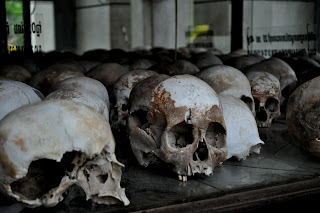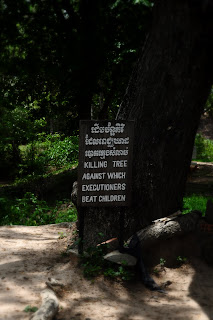However, what I can’t help but wonder though, is how is it possible that a country that has been through so much grief, so much tragedy, so much injustice be so warm and welcoming? How can a population that has faced the brutality and inhumanity that they have find the courage to smile so much?
My first day in Phnom Penh was a free day. In the morning I met up with Kendra (I couldn’t believe she actually made it!) and after catching up on all things work- and nonwork-related, we made our plan for the day. The first stop was a heavy one: the Killing Fields at Choeung Ek. One might wonder why I chose to make this my first place of visit here. One might suggest that I wait a bit, enjoy some “happier” places first. But, this was what had fueled my desire to come to Cambodia for the last 10 years. Not because I’m fascinated with death or injustice. Not because I have a masochistic desire to subject myself to such sadness and tragic remembrance. But, because I am inspired by the survival and recovery (though not nearly complete) that the people of Cambodia have progressed through. Just as the Tutsi people of Rwanda somehow miraculously found the compassion, the vitality, the sheer strength to persevere through the horrific genocide in the 90s only to come out with the unbelievable motivation to reconcile with their killers, the Hutus, Cambodia has managed to somehow find joy in a world that was ravaged with insurmountable hate, violence, and transgression.
While it has been a place at the top of my list of sites to visit and pay respect to, I really didn’t know what to expect at Choeung Ek. I only knew a surface level of the history and facts surrounding the events that took place between 1975 and 1979; I had never visited a place such as this. The documentaries that I had seen contained images 20+ years old, and the influential Hollywood film, The Killing Fields, is now close to 30 years old.
What I encountered was a very well-done, extremely informative, and down-right impressive place of respect, memory, and tribute. During our exploration of the memorial, we saw a film that gave us a 20-minute overview of the events leading up to and following the 4-year massacre. It provided the context for which we were about to see on our walk around the grounds: mass graves, weapons used for torture and slaying, remnants of children’s clothing, and the display of the bones of thousands of victims. While I choked back my tears, I embraced the information fully, trying my best to memorize not only the history that I was learning, but also the emotion that this experience was evoking in me.
And, later, as I walked through the streets of Phnom Penh, and the next day through the paths of a rural village, I was (and continue to be) astounded and inspired by the smiles – not only on the faces, but in the eyes – of the people before me. I am compassionate, I am forgiving, I am happy; but, can I honestly say that I know in my heart that I would be as compassionate, forgiving, and seemingly happy after a tragedy such as this? I simply cannot. And so, in that uncertainty, I can only aspire to be like the Cambodian people, to have the capacity to love, to persevere, and to smile – not only with my face, but with my eyes and with my heart.





No comments:
Post a Comment